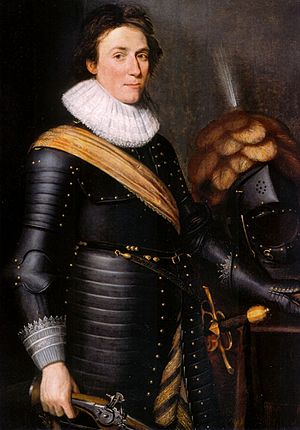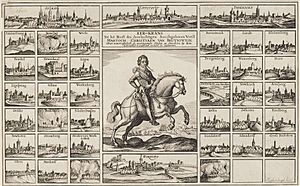Christian the Younger of Brunswick facts for kids
Christian the Younger of Brunswick-Wolfenbüttel (born September 20, 1599 – died June 16, 1626) was a German nobleman and soldier. He was a member of the House of Welf, a powerful family. Christian was also in charge of the Bishopric of Halberstadt, which gave him money for his military plans. He became a key Protestant military leader. He fought in the early years of the Thirty Years' War. This was a big war against the House of Habsburg and the Catholic League.
Contents
Christian's Early Life and Role
Christian was born in 1599 in a place called Gröningen Priory. This was near Halberstadt in what is now Saxony-Anhalt, Germany. He was the third son of Duke Henry Julius of Brunswick-Lüneburg. His mother was Elizabeth, who was the daughter of King Frederick II of Denmark.
After his father passed away, Christian was raised by his uncle, King Christian IV of Denmark. He also studied at the University of Helmstedt. In 1616, when he was just 17, his brother Rudolf died. Christian was then chosen to take over as the Lutheran leader of the Halberstadt area. This role gave him the money he needed to start his career as a soldier.
Christian's Military Adventures
In 1620, Christian joined the army of Prince Maurice of Orange. He fought against the Spanish army in the Netherlands. Later, he created his own army. He supported Frederick V, Elector Palatine, a Protestant leader. Christian fought in three important battles:
- The Battle of Höchst in 1622
- The Battle of Fleurus (1622) in 1622
- The Battle of Stadtlohn in 1623
Christian's army often took supplies and resources from the areas they passed through. He fought alongside the Count of Mansfeld in the first two battles. He lost twice to the army led by Count of Tilly. One loss was at Höchst, and his final big loss was at Stadtlohn.
Christian's biggest success was at Fleurus. His actions helped save the Protestant city of Bergen op Zoom. He died in 1626 from injuries he got in battle. He did not have any children.
Campaigns of 1622-1623
In 1621, Christian was one of the few people who still supported Frederick V. Frederick had lost his throne in Bohemia after a big defeat. Frederick was still leading the Protestant fight that started in 1618. Christian may have joined because he admired Elizabeth, Frederick's wife. She was the daughter of King James I of England. England had sent troops to help the Protestants.
By the end of 1621, Christian had gathered about 10,000 soldiers. They spent the winter in Westphalia. They collected a lot of money from the areas of Münster and Paderborn.
Christian's military actions began in 1622. Ernst von Mansfeld wanted to join forces with Christian. This was especially true after their ally, Georg Friedrich, Margrave of Baden-Durlach, lost badly at the Battle of Wimpfen. Christian's army was caught at the Battle of Höchst on June 22, 1622. Even though he was defeated, he managed to escape with most of his army. He crossed a river under heavy fire, but he lost all his supplies.
The Protestant armies then moved into Alsace. This meant Heidelberg, the capital of the Palatinate, fell to Count von Tilly in September 1622. This forced Frederick V out of the war.
After taking many supplies in Alsace, Christian and Mansfeld moved north. They heard that the Spanish were attacking Bergen op Zoom. They marched to help the city. They fought the Battle of Fleurus on August 29, 1622. During the battle, Christian showed great bravery. He led four cavalry charges against the Spanish lines. On the fifth charge, his horsemen broke through. This helped the Protestants save Bergen op Zoom that October. However, Christian lost most of his foot soldiers and one of his arms in this battle.
After this victory, Christian spent the winter of 1622–23 in the Spanish Netherlands. He rested and rebuilt his army. By spring 1623, he had about 15,000 soldiers.
In spring 1623, Christian, Mansfeld, and other Protestant leaders planned to take back Bohemia. But the plan failed early on. Count von Tilly found out about their movements. He positioned his army in Lower Saxony. Mansfeld also told Christian he didn't have enough money for his soldiers. This left Christian on his own in the north.
Christian's army was smaller and not as well-trained as Tilly's. Christian tried to escape to the United Provinces. But he was caught just 10 miles from the Dutch border. He was bravely defeated at the Battle of Stadtlohn on August 6, 1623. He lost all but 2,000 of his 15,000 soldiers. Broken, he fled to The Hague with the few remaining soldiers.
Defeat and Death
Christian's defeat marked the end of the "Palatine Phase" of the Thirty Years' War. It also ended the main Protestant rebellion at that time. Three days after Stadtlohn, Frederick V made a peace agreement with Ferdinand II. This ended Frederick's fight against the growing power of the Catholic side.
Mansfeld soon disbanded his army. In 1625, Denmark-Norway, the United Provinces, and England joined the war. Christian was part of a new plan with Mansfeld and Christian IV, the King of Denmark-Norway. They would attack from different directions. Christian received good financial support for this.
He was ordered to advance into the Rhineland. But he was stopped by Tilly in Hesse. This time, Christian chose to retreat instead of fighting. He was sick at the start of this campaign. Christian died at Wolfenbüttel on June 16, 1626. He was 26 years old.
See also
 In Spanish: Cristián de Brunswick para niños
In Spanish: Cristián de Brunswick para niños



